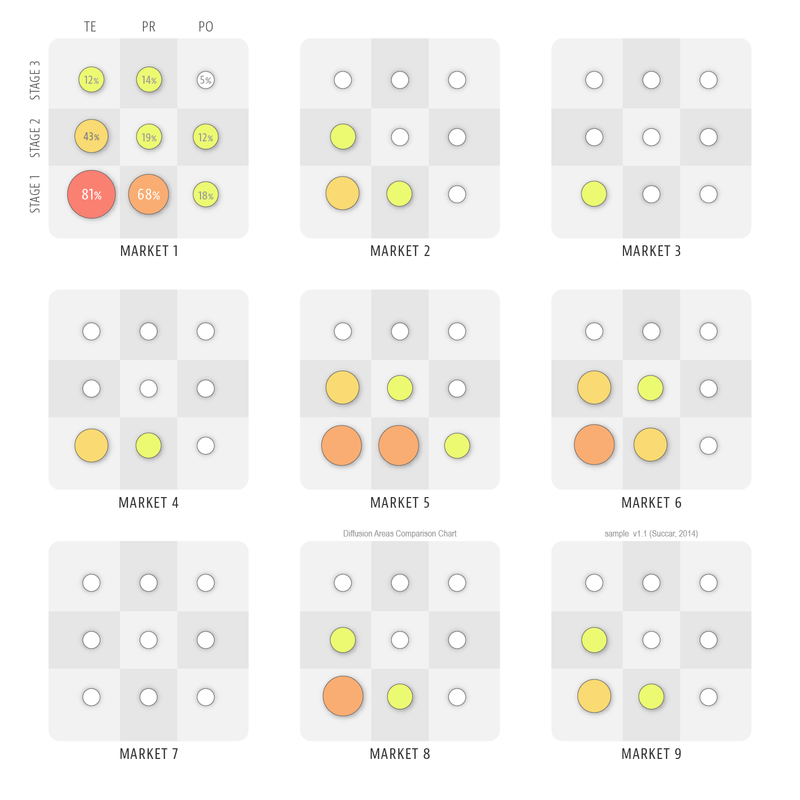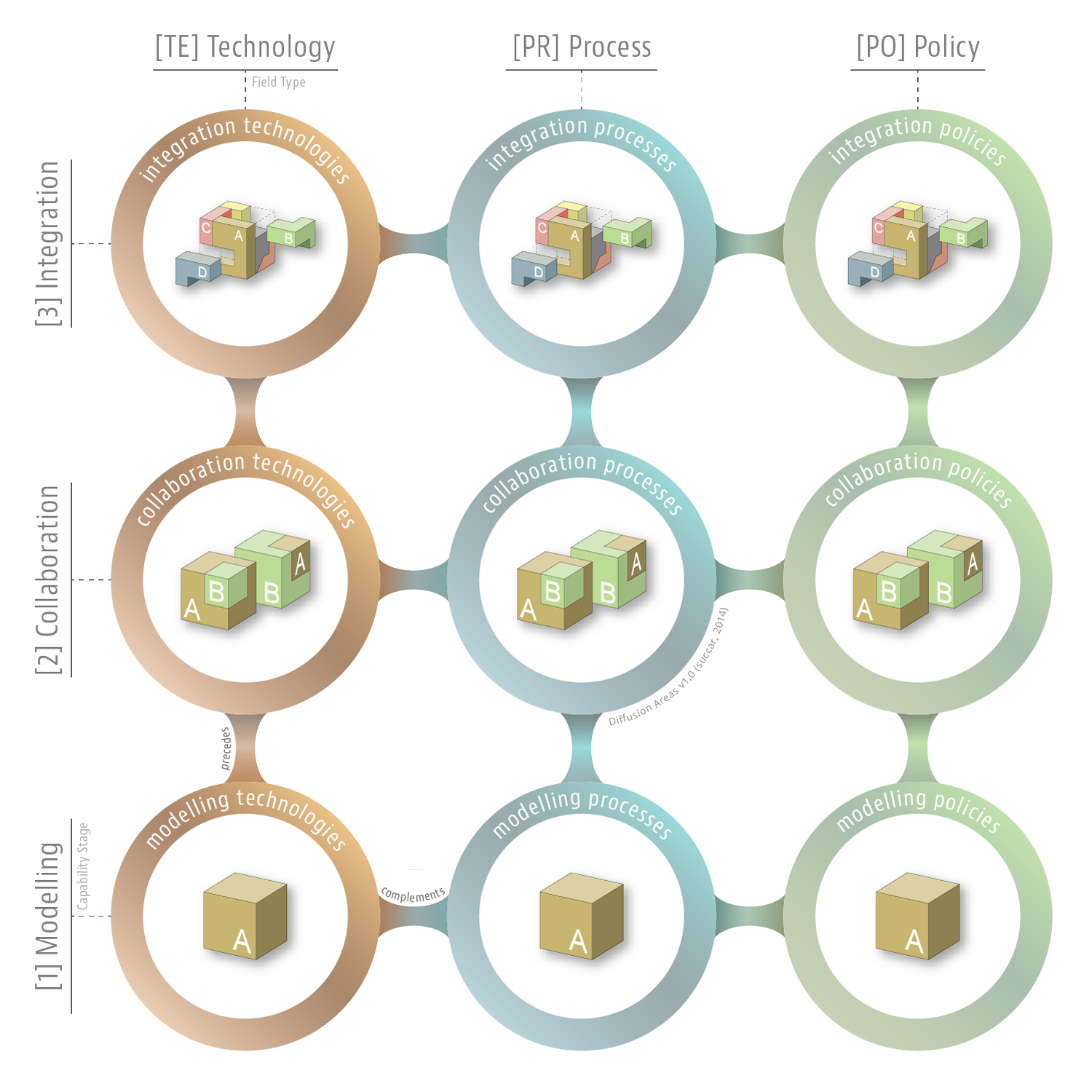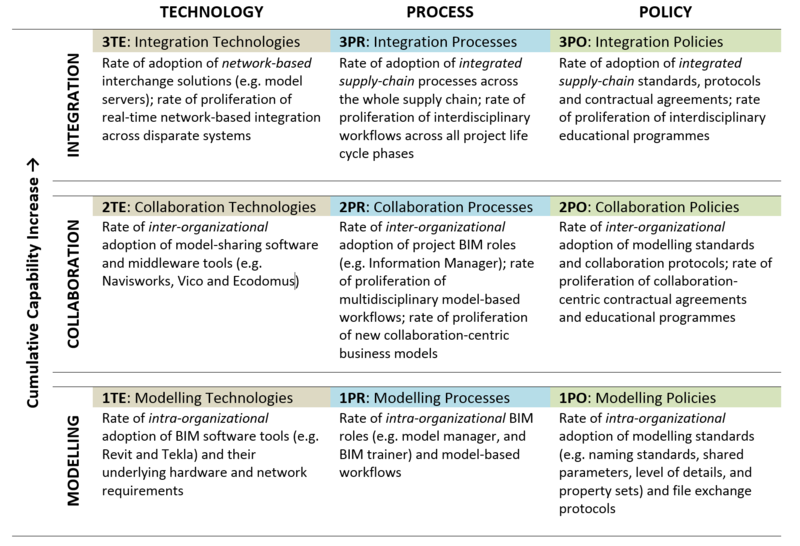
This numbered Frameworks Page covers a single Visual Knowledge Model (VKM). Refer to Tags at the bottom for content classification and source publication if any. The page may be updated to connect with newer Frameworks Pages. The number is for pages, not for content.
Published on May 27, 2015 | Last Updated on September 20, 2025
This conceptual model (Figure 1) clarifies how BIM Field types (technology, process and policy) interact with BIM Capability Stages (modelling, collaboration and integration) to generate nine areas for targeted BIM diffusion analysis and BIM diffusion planning:
Figure 1. Diffusion Areas model v1.0 (full size, current version)
The nine diffusion areas, explored in the below table, can be assessed independently or collectively. For example, the diffusion of BIM software tools within a population (modelling technologies [1TE]) can be assessed separately, and using different assessment methods, than establishing the proliferation of integrated project delivery contracts (integration policies [3PO]). Also, the diffusion of multidisciplinary BIM educational curricula (collaboration policies [2PO]) can be assessed separately, or in combination with, the proliferation of collaborative BIM roles and responsibilities (collaboration processes [2PR]).
Table 1. Diffusion Areas matrix (with sample granular metrics within each diffusion area)
The nine diffusion areas, their structured subdivisions and combinations, provide an opportunity for granular assessments of BIM diffusion within a population of adopters. Rather than being treated uniformly as a single set of data, or separated into disparate topics without an underlying conceptual structure, the Diffusion Areas’ model (Figure 1) allows the generation of targeted ratings for comparative market analysis – as exemplified in Figure 2:
 Figure 2. Diffusion Areas Comparison sample chart v1.1 – updated April 24, 2016 (full size, current version)
Figure 2. Diffusion Areas Comparison sample chart v1.1 – updated April 24, 2016 (full size, current version)
Below is a short video explaining the above, as available on the Framework’s YouTube channel:
Please note that the above model, table and chart are part of five macro adoption models collated within “Succar, B., & Kassem, M. (2015). Macro-BIM adoption: Conceptual structures. Automation in Construction, 57, 64-79″. Download full paper from here: http://bit.ly/BIMPaperA8
Cite as: BIMe Initiative (2025), '34. Diffusion Areas', https://bimexcellence.org/frameworks/diffusion-areas/. First published 27 May 2015. Viewed 25 November 2025


Hi, may I suggest to refer to more diffused classification both of BIM dimensions and BIM uses.
Dear Prof Esposito…Thank you for your suggestion.
Model Uses (or ‘BIM uses’ – please refer to http://bit.ly/BIMepisode24) are project metrics and – in my view – cannot be used for assessing BIM diffusion at macro/market level. Please let me know if I misunderstood your suggestion.
To further clarify the Diffusion Areas model, I’ve now embedded a short video above. This video (aprox 8 minutes) is part of a series of videos we’re currently using to validate five macro adoption models. For more information, or to participate in this research, please visit: http://www.bimframework.info/macro-bim-adoption-market-analysis.html; thank you.